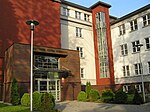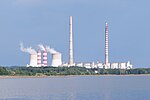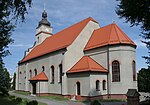Śródmieście, Rybnik
Districts of RybnikSilesian geography stubs

Śródmieście [ɕrudˈmjɛɕt͡ɕɛ] ('city centre') is a district of Rybnik, Silesian Voivodeship, southern Poland. In the late 2013 it had about 7,700 inhabitants.The quarter encompasses the traditional area of Rybnik, old city, with market square, town hall, Basilica of St. Anthony, Our Lady of Sorrows church, Lutheran church, former Piast castle, theatre.
Excerpt from the Wikipedia article Śródmieście, Rybnik (License: CC BY-SA 3.0, Authors, Images).Śródmieście, Rybnik
Rynek, Rybnik Śródmieście (Śródmieście)
Geographical coordinates (GPS) Address Nearby Places Show on map
Geographical coordinates (GPS)
| Latitude | Longitude |
|---|---|
| N 50.095589 ° | E 18.541999 ° |
Address
Rynek
Rynek
44-200 Rybnik, Śródmieście (Śródmieście)
Silesian Voivodeship, Poland
Open on Google Maps










